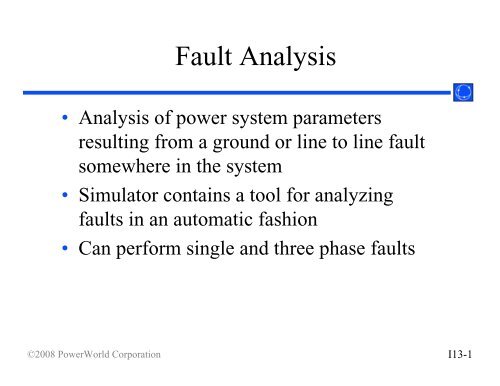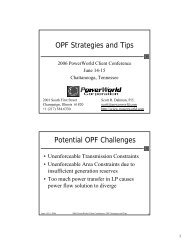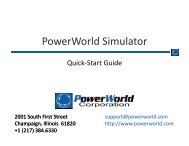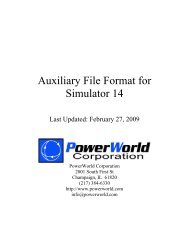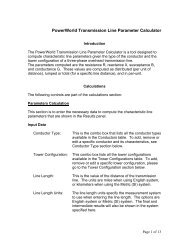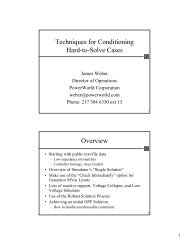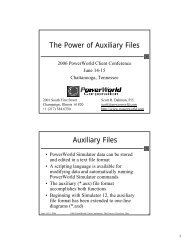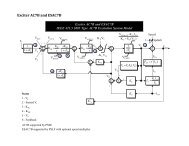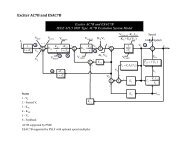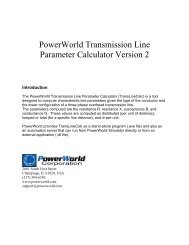Fault Analysis - PowerWorld
Fault Analysis - PowerWorld
Fault Analysis - PowerWorld
You also want an ePaper? Increase the reach of your titles
YUMPU automatically turns print PDFs into web optimized ePapers that Google loves.
©2008 <strong>PowerWorld</strong> Corporation<br />
<strong>Fault</strong> <strong>Analysis</strong><br />
• <strong>Analysis</strong> of power system parameters<br />
resulting from a ground or line to line fault<br />
somewhere in the system<br />
• Simulator contains a tool for analyzing<br />
faults in an automatic fashion<br />
• Can perform single and three phase faults<br />
I13-1
©2008 <strong>PowerWorld</strong> Corporation<br />
<strong>Fault</strong> <strong>Analysis</strong><br />
• <strong>Fault</strong> types include:<br />
– Single line to ground<br />
– Line to line<br />
– Double line to ground<br />
– Three phase balanced<br />
• The general fault analysis tool can be<br />
accessed in run mode by: Tools ribbon tab<br />
<strong>Fault</strong> <strong>Analysis</strong><br />
I13-2
• Information about the fault location can be filled in<br />
manually<br />
• Alternatively, you can right-click on a bus or transmission<br />
line on the oneline diagram, and select <strong>Fault</strong>… from the<br />
menu to have the fault location fields automatically set<br />
– Selecting <strong>Fault</strong>… for a bus will set the bus number field<br />
– Selecting <strong>Fault</strong>… for a transmission line will set the from and to<br />
bus numbers, the circuit identifier, and the approximate line<br />
location as a percentage of the length of the line<br />
– Any of these fields can still be changed manually<br />
©2008 <strong>PowerWorld</strong> Corporation<br />
Setting the <strong>Fault</strong> Location<br />
I13-3
©2008 <strong>PowerWorld</strong> Corporation<br />
Select Type of <strong>Fault</strong><br />
• Determines which calculations to perform<br />
– Line to ground: assumes phase A to ground<br />
– Line to line: assumes phase B to phase C<br />
– Line to line to ground: assumes phase B to phase C to<br />
ground<br />
– Three phase balanced<br />
• A non-zero impedance to ground can be defined on<br />
the options tab, default is 0 (except for line to line)<br />
I13-4
Devices<br />
listed here<br />
depend on<br />
bus or inline<br />
fault<br />
©2008 <strong>PowerWorld</strong> Corporation<br />
<strong>Fault</strong> Dialog: Data<br />
Set type of<br />
fault<br />
Results of analysis are displayed<br />
in the grids on these five pages<br />
Current through<br />
the fault<br />
I13-5
Sequence Data for <strong>Fault</strong> <strong>Analysis</strong><br />
• By default, sequence data for fault analysis is not<br />
stored with load flow data<br />
• Sequence data can be loaded from the Options<br />
page<br />
– <strong>PowerWorld</strong> Auxiliary file (*.aux)<br />
– PTI Sequence Data file (*.seq)<br />
• Sequence data can similarly be saved to the same<br />
types of external files; however, Simulator will<br />
store sequence data with the load flow case<br />
(*.pwb) if you save the case after loading the<br />
sequence data<br />
©2008 <strong>PowerWorld</strong> Corporation<br />
I13-6
Sequence Data for <strong>Fault</strong> <strong>Analysis</strong><br />
• Sequence data is required for various<br />
devices:<br />
– Generators<br />
©2008 <strong>PowerWorld</strong> Corporation<br />
• Internal sequence impedances<br />
• Neutral to ground impedance<br />
– Transmission Lines<br />
• Zero sequence impedance<br />
• Zero sequence line shunt admittance<br />
I13-7
Sequence Data for <strong>Fault</strong> <strong>Analysis</strong><br />
– Transformers<br />
• Zero sequence impedance and line shunt admittance<br />
• Phase shifts, entered as Phase in the load flow data<br />
• Transformer grounding configuration, as a<br />
combination of Wye, Grounded Wye, and Delta<br />
connections<br />
– Loads<br />
• Negative and zero sequence load, as an admittance<br />
• Set on a bus-basis, with admittance given is total<br />
admittance for all loads at that bus<br />
©2008 <strong>PowerWorld</strong> Corporation<br />
I13-8
Sequence Data for <strong>Fault</strong> <strong>Analysis</strong><br />
• Transmission line mutual impedance<br />
– Zero sequence mutual impedance between part<br />
or all of two transmission lines<br />
– Displayed on Options tab<br />
• <strong>Fault</strong> data for all devices (except mutual<br />
impedances) can be entered on the<br />
Information Dialogs<br />
©2008 <strong>PowerWorld</strong> Corporation<br />
I13-9
Impedance to<br />
ground at the fault<br />
©2008 <strong>PowerWorld</strong> Corporation<br />
<strong>Fault</strong> <strong>Analysis</strong>: Options<br />
Load and save sequence data<br />
as a text file<br />
Mutual<br />
impedance<br />
records<br />
I13-10
©2008 <strong>PowerWorld</strong> Corporation<br />
<strong>Fault</strong> <strong>Analysis</strong> Example<br />
• Open B7<strong>Fault</strong>Example.pwb<br />
– No sequence data exists, so all fault analysis data fields<br />
are set to defaults<br />
• Run the <strong>Fault</strong> <strong>Analysis</strong> tool from run mode by:<br />
Tools ribbon tab <strong>Fault</strong> <strong>Analysis</strong><br />
• From the <strong>Fault</strong> Options tab, select Load Data<br />
– Confirm replacing sequence data<br />
– Load B7<strong>Fault</strong>Example.aux<br />
I13-11
©2008 <strong>PowerWorld</strong> Corporation<br />
<strong>Fault</strong> <strong>Analysis</strong> Example<br />
• Switch to the <strong>Fault</strong> Data tab, and select fault<br />
bus number 3<br />
• Leave as bus fault, single line to ground<br />
• Click Calculate<br />
– The case will be solved first to make sure the<br />
analysis will be valid<br />
– The fault analysis calculation is a linearized<br />
calculation about the operating point<br />
I13-12
©2008 <strong>PowerWorld</strong> Corporation<br />
<strong>Fault</strong> <strong>Analysis</strong> Example<br />
• Results are displayed on the five tab sheets on the<br />
<strong>Fault</strong> Data page<br />
– Per phase bus voltage magnitude (p.u.) and angle (deg.)<br />
– Per phase branch from and to bus current magnitude,<br />
with current direction at BOTH ends defined AWAY<br />
from the terminal bus<br />
– Per phase generator current magnitude and angle (deg.),<br />
with current direction defined OUT of the generator<br />
– Per phase load and switched shunt magnitude, with<br />
current direction defined AWAY from the terminal bus<br />
I13-13
<strong>Fault</strong> <strong>Analysis</strong> Visualization of<br />
©2008 <strong>PowerWorld</strong> Corporation<br />
Results<br />
• Voltages and currents calculated during<br />
<strong>Fault</strong> <strong>Analysis</strong> can be visualized on a<br />
oneline diagram<br />
– In the Data Type Shown on Oneline box, select<br />
a single phase or all phases<br />
– When Data Type Shown is changed to phase or<br />
phases, Simulator searches for and replaces the<br />
following types of text fields on the oneline<br />
diagram:<br />
I13-14
<strong>Fault</strong> <strong>Analysis</strong> Visualization of<br />
©2008 <strong>PowerWorld</strong> Corporation<br />
Results<br />
• Bus voltage fields replaced with phase voltage magnitude(s) in<br />
p.u.<br />
• Bus angle fields replaced with phase voltage angle(s) in<br />
degrees<br />
• Branch MW or Amp fields replaced with phase current<br />
magnitude(s) in Amps or p.u., as specified<br />
• Branch MVAR fields replaced with phase current angle(s) in<br />
degrees<br />
• Generator MW fields replaced with phase current magnitude(s)<br />
in Amps or p.u., as specified<br />
• Generator MVAR fields replaced with phase current angle(s)<br />
in degrees<br />
I13-15
Only fields<br />
switched to<br />
fault analysis<br />
results will<br />
remain on<br />
oneline<br />
Currents shown<br />
are magnitude<br />
only; would<br />
need to include<br />
angles to<br />
determine<br />
direction<br />
<strong>Fault</strong> <strong>Analysis</strong> Visualization of<br />
©2008 <strong>PowerWorld</strong> Corporation<br />
Results<br />
I13-16
<strong>Fault</strong> <strong>Analysis</strong> Visualization of<br />
©2008 <strong>PowerWorld</strong> Corporation<br />
Results<br />
• The phase of the fault data displayed on the<br />
diagram can be quickly toggled to a<br />
different phase by clicking on the dropdown<br />
arrow on the <strong>Fault</strong> <strong>Analysis</strong> toolbar<br />
button and choosing a new visualization<br />
setting<br />
I13-17
©2008 <strong>PowerWorld</strong> Corporation<br />
In-Line <strong>Fault</strong>s<br />
• Calculated based on a location given as a<br />
percentage distance from the From end of<br />
the line<br />
• Inserts a temporary bus and line segments<br />
representing the fault point of the line;<br />
reflected on the oneline diagram<br />
• Calculations performed the same as a bus<br />
fault at the temporary bus<br />
I13-18
©2008 <strong>PowerWorld</strong> Corporation<br />
<strong>Fault</strong> <strong>Analysis</strong>: Final Notes<br />
• The fault analysis form can be closed while a fault<br />
is calculated without clearing the fault; the values<br />
will remain in memory until manually cleared or<br />
the case is saved or closed<br />
• A Double Line fault automatically uses a <strong>Fault</strong><br />
Impedance of 999+j999 and ignores the <strong>Fault</strong><br />
Impedance settings; use a Double Line to Ground<br />
fault to specify a desired <strong>Fault</strong> Impedance<br />
I13-19
©2008 <strong>PowerWorld</strong> Corporation<br />
<strong>Fault</strong> <strong>Analysis</strong>: Final Notes<br />
• Before visualizing fault analysis currents in<br />
p.u., you may need to first change the<br />
number of decimal places for the branch<br />
and generator MW and MVAR fields<br />
• Once Sequence Data is loaded from an<br />
external file, saving the case file will store<br />
the sequence data with the *.pwb as well<br />
I13-20


